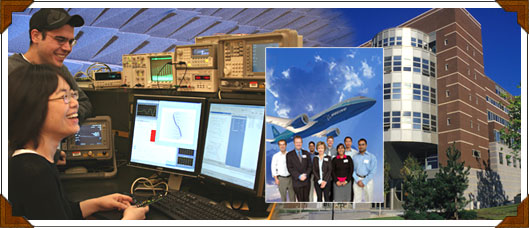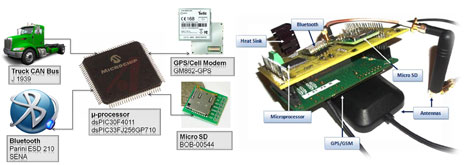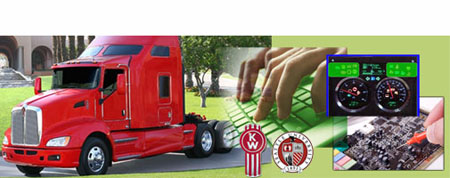
Project Examples
Here Comes the Sun - Team PACCAR completed design work on one of Washington State's largest solar arrays

Eric Hee is one of the SU students who worked on a path-breaking solar project with PACCAR.
Story by:Amy Haedt A man from Japan, a man from China, a man from France, a man from Hawaii and a man from Washington all walk into a truck factory… What's the punch line? The amazing truth is there is no punch line. This is a truly international SU Project Center team, working on a truly innovative solar power project with Kenworth Truck Company that will mark the company's truck production plant in Renton as one of the largest non-utility scale photovoltaic (PV) solar arrays in the state.
Electrical and Computer Engineering students Junya Motoike, Siyu Zhang, Christopher Rabotin, Eric Hee and Don Sable have been charged with creating a design for a series of solar panels to be installed on the top of a building on the PACCAR/Kenworth campus in Renton, Washington. "Drivers on I-405 will be able to look out their windows and see one of the largest PV systems in the state of Washington." says Kenworth Truck Company project sponsor, Facilities Engineer Frank Churchill.
"The goal of the project is to offset the annual energy consumed by the PACCAR Technology Center," says Electrical and Computer Engineering Professor Henry Louie. "To do this requires a 36 kilowatt installation, consisting of over 190 PV panels," Louie adds. Seattle University currently has an array that produces 5.3 kW of power. The peak output of the Kenworth system will be nearly 7 times that of the SU system.
"The largest challenge with this project was to learn about solar panels and how a system of PV arrays work," says Christopher Rabotin of France. "The international composition of our project team was really a great experience," adds Don Sable. "We have a lot of different cultural perspectives, but we learned about valuable technology that we can each bring to our future careers regardless of the country where we are employed."
"Germany, for example, produces the most solar power in the world. It's heavily subsidized," says Louie. "In the US we must make the business case that the recovered energy justifies the investment," adds Churchill. He continues, "Energy costs increased 3.8 percent in the month of April alone. If this system can result in direct transmission to the facility, the cost savings on energy may be quite tangible."
Patient Data Tracking Using RFID Technology
Team ECE 08.05
Sponsor: Philips Medical Systems
Collaborating Senior Design Team Members: Riley Higa, Andrew Kurniadi, Min Kyeong Lee, Robert Nguon, and Mark John Merin.
Philips Medical Systems and the Seattle University's Electrical & Computer Engineering Team collaborate on the development of a process of automation of patient data entry in hospitals and diagnostic ultrasound clinics using RFID Technology.
Traditionally, hospital patients are identified by wristbands, medical notes are physically carried from place to place, and schedules are hastily rewritten as things change. Mix-ups can result in patients having the wrong records, the wrong drugs being administered, and even the wrong surgery being performed.
 (Radio Frequency Identification) is a method of storing and remotely retrieving data using devices called RFID tags. When you buy a pair of pants it often has a RFID tag attached so why not tag a patient's wristband?
(Radio Frequency Identification) is a method of storing and remotely retrieving data using devices called RFID tags. When you buy a pair of pants it often has a RFID tag attached so why not tag a patient's wristband?
In support of Philips Healthcare's commitment to quality patient care our team designed, built, and presented an innovative RFID solution using:
- Texas Instruments microprocessor-controller.
- Designing and building of a miniaturized printed loop antenna.
- Advanced Encryption Standard 256 bit keys for personal data security.
- Compression Algorithm based on a combination LZ77 and Huffman Coding to store the quantity of data on the tag.
- The design was completed well within the original budget.
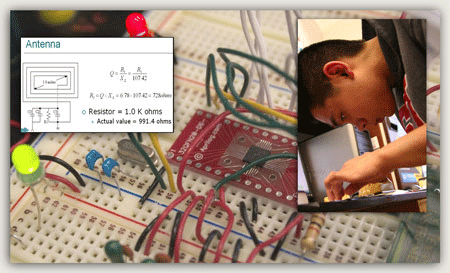
ONBOARD VEHICLE DATA ADAPTER
Team ECE 08.04
Sponsor: Paccar
In modern business models, data is key to increased competitiveness and profits. PACCAR Inc. wishes to acquire more data about the functioning of their trucks in day-to-day work in order to improve fleet productivity, accountability, and profitability The goal was to add more features to the existing Bluetooth Data Link Adapter built last year by SU design team ECE07.5. The final device has to be able to collect, store and send real-time heavy duty trucks' data such as speed, acceleration, battery potential, etc.
PACCAR was founded in 1905 by William Pigott as the Seattle Car Manufacturing Company. Its original business was the production of railway and logging equipment. After a merger with Towhy Brothers, a Portland Oregon firm, Seattle Car Manufacturing Company became the Pacific Car and Foundry Company. During WWII, it was involved in the war effort with the production of 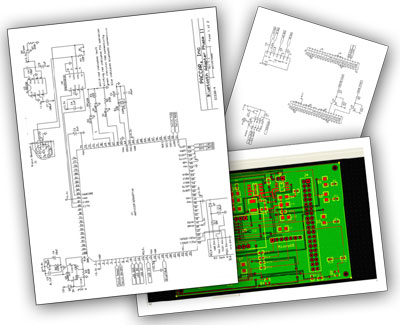 Sherman tanks for the US army. After numerous merger and acquisitions (Kenworth Motor Truck Company in 1945, Peterbilt Motors Company in 1958, …), the corporate name was officially changed to PACCAR Inc. in 1972. Nowadays, PACCAR is the third largest manufacturer of heavy-duty trucks in the world (after Volvo and DaimlerChrysler).
Sherman tanks for the US army. After numerous merger and acquisitions (Kenworth Motor Truck Company in 1945, Peterbilt Motors Company in 1958, …), the corporate name was officially changed to PACCAR Inc. in 1972. Nowadays, PACCAR is the third largest manufacturer of heavy-duty trucks in the world (after Volvo and DaimlerChrysler).
Hardware Work In order to design the general schematic of our project, we used a software called Express PCB. It is composed of two different applications: ·ExpressSCH to design schematics ·ExpressPCB to design the layout board

Dr. Moser (Faculty Project Advisor),Mark Fredrickson (Liaison Engineer), Fabio Florez, Eliott Cahen,Gina Castro Marine Pennaguer,Trent Styrcula,
Not in the picture: Rob Branson & Rusty Lhamon (Sponsor Liaison)
Sky High Energy Harvesting

TEAM ECE 08.01
Sponsor: The Boeing Company
Everyone wants to save on fuel costs. Whether it's an automobile, a home gas furnace, or a Boeing 787 caring 35,000 gallons of fuel. Fuel efficiency is a priority. Just ask the Boeing and Seattle University team where their daily challenges lies in the application of a new developing technology to convert temperature gradients, those differences in temperature found between the inside and the outside of an airplane, into electricity. Their goal: design a solution to harvest electricity at a capacity to powering electrical devices in the passenger cabins of commercial aircrafts.
The Boeing Company is at the heart of modern aviation and space travel. The principal areas of Boeing operations include commercial airplanes, military aircraft, defense missile systems, and space and satellite communications. The Boeing Systems Concept Center and Seattle University have common goals. "We focus our work on products that Boeing manufactures today as well as products for tomorrow's customer," said Boeing Liaison Engineer "We're always looking at futuristic design concepts and finding new and innovative ways to implement ideas."
Energy Harvesting
Aircraft, especially at high altitude, are subject to large temperature gradients. Our team researched and designed methods to exploit these temperature gradients using thermoelectric devices that convert the thermal energy to electrical energy. The purpose is to reduce the weight of the airplane (eg the copper wiring) by distributing these harvesting power supplies throughout the aircraft.
 The thermoelectric effect is the direct conversion of temperature differences to electric voltage and vice versa. Simply put, a thermoelectric device creates a voltage when there is a different temperature on each side, and when a voltage is applied to it, it creates a temperature difference. This effect can be used to generate electricity, to measure temperature, to cool objects, or to heat them. An applied temperature difference causes charged carriers in the material to diffuse from the hot side to the cold side, similar to a classical gas that expands when heated. Mobile charged carriers migrating to the cold side leave behind their oppositely charged and immobile nuclei at the hot side thus giving rise to a DC voltage.
The thermoelectric effect is the direct conversion of temperature differences to electric voltage and vice versa. Simply put, a thermoelectric device creates a voltage when there is a different temperature on each side, and when a voltage is applied to it, it creates a temperature difference. This effect can be used to generate electricity, to measure temperature, to cool objects, or to heat them. An applied temperature difference causes charged carriers in the material to diffuse from the hot side to the cold side, similar to a classical gas that expands when heated. Mobile charged carriers migrating to the cold side leave behind their oppositely charged and immobile nuclei at the hot side thus giving rise to a DC voltage.
There are many benefits of harvesting electricity using thermoelectric devices:  No moving parts
No moving parts  Requires little maintenance
Requires little maintenance  High life expectancy (11+ years of operation)
High life expectancy (11+ years of operation)  Does not contain any materials that require periodic replenishment. ·
Does not contain any materials that require periodic replenishment. · Thermoelectric devices are rugged and can withstand harsh conditions.
Thermoelectric devices are rugged and can withstand harsh conditions.  Can be mounted anywhere and in any direction
Can be mounted anywhere and in any direction
Boeing Green Sky Thinking
The aerospace giant hopes to blaze a cleaner trail with its Dreamliner – it uses 20 per cent less fuel than most jets and is developing a light aircraft prototype powered by hydrogen fuel cells. If Boeing finds a way to make the hydrogen fuel cells lighter, cheaper and more powerful, the new technology could represent a radical breakthrough within the commercial aviation industry. It is an initiative by the world's aircraft maker to develop alternative fuels at a time when the price of jet fuel is soaring and amid growing environmental concerns.
One of the purposes for developing energy harvesting systems is to reduce the amount of copper power cables in an aircraft by placing small energy harvesting power supplies near the point of use. The harvested energy has the potential to power simple aircraft cabin systems such as convenience lights, reading and call lights, or electronically tinted windows. Another possible application of the harvested energy is to store the energy in rechargeable batteries for later use. These developments could lead to patentable intellectual property as well.

One of the challenges facing our team was developing a conditioning system to boost the low voltage outputs of the thermoelectric devices, typically in the range of 0.4 - 0.7 volts, to a more usable voltage capable of powering electronics. Other constraints where weight, extreme conditions and strains such as vibration and changing temperature gradients.
GPU Based Image Processing Real-Time JPEG Codec

Team ECE 07.03
Sponsor: Philips Medical Systems
Philips Medical Systems teams up with Seattle University to develop a new JPEG encoding process to save cost and improve reliability of it's ultrasound machines.

Our team accomplished the goal by transferring the processing load of encoding JPEG files from higher cost Application Specific Integrated Circuits (ASIC) to the Graphics Processing Unit (GPU) of a video card.
Automated Multicolor In-Cluster Tell-Tale System
Team ECE 07.03
Sponsor: The Boeing Company
Seattle University Senior Students working jointly with Kenworth got their boots muddy in a project consisted of "proof of concept" design and prototype for Kenworth's Automated Tell-Tale Identification and multi-color Tell-Tale systems. These systems, when implemented, will allow Kenworth to provide a higher quality, more flexible product at a lower cost. It is joint projects such as these that provide students with an unprecedented opportunity to tap into the rich resources, knowledge, and unique skills of world-class companies such as Kenworth to produce the very best educational experience .
Kenworth Truck Company, a division of PACCAR Inc, is a leading manufacturer of heavy and medium duty trucks. Kenworth's success can be traced back to a philosophy established at the beginning in 1923: Build a custom truck and build it to last. Back then, it was said that Kenworth engineers weren't afraid to "get their boots muddy" as they journeyed into the field with customers to understand the demands put on their vehicles. Today, Kenworth continues to listen carefully to customer needs, then builds custom trucks that will meet those needs. That's why they call them "The World's Best."
